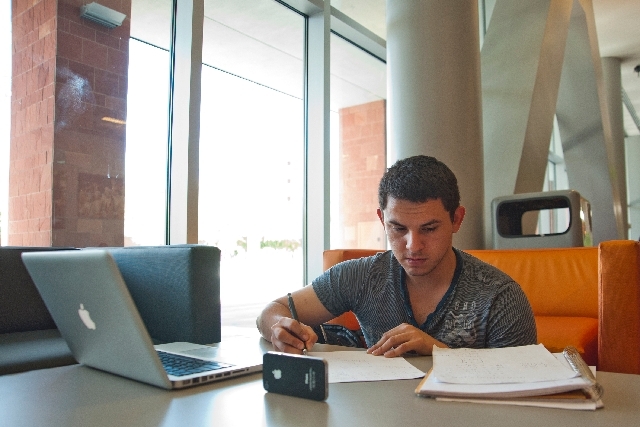As Congress debates loan rates, some Nevada students face mounting debt
Congress is nearing a deadline to reach a deal to keep rates on some student loans from doubling. If it doesn’t act by July 1, Rick Hannu and Manuel Villarreal could be driven further into debt to earn their degrees from the University of Nevada, Las Vegas.
During the current summer term, Hannu, a freshman at UNLV, is using income from various part-time jobs to cover the cost of his tuition. But, to finish in four years, he is looking for financial aid, scholarships or loans to help cover his $6,000 in tuition and fees per year.
“The economy is what sent me to school,” Hannu said. “I chose hotel management because I thought it wouldn’t be a bad career choice.”
Hannu, 35, said that after a glitch denied his federal aid request, he is re-applying for federal student loans.
Under a temporary agreement reached last year, interest rates were set at 3.4 percent on new subsidized federal Stafford loans, but the rate would double to 6.8 percent on July 1.
President Barack Obama has called for a long-term solution that would see interest rates tied to the 10-year Treasury note, which would mean they would float higher than the current 3.4 percent. A bill introduced by Sen. Richard Burr, R-N.C., is similar to the president’s view.
Burr’s Comprehensive Student Loan Protection Act would set newly issued federal loans at the U.S. Department of Treasury 10-year borrowing rate plus
3 percentage points. That would set the interest rate for this coming school year for all new federal loans to a fixed rate of
4.75 percent, based on the May 15 treasury auction rate of 1.75 percent.
The interest rate would change from year to year, but once the loan is taken out, the rate would remain unchanged for the life of the loan. But Democrats are opposed to the Obama and Republican efforts because student loan rates would fluctuate with the market.
Floris Mendonza, who will complete his MBA next month, said as a former graduate assistant with the Rebels football team, he was fortunate to have his tuition picked up by UNLV. But Mendonza, 26, is still concerned.
“So far, I’ve been lucky I didn’t have to take out loans,” Mendonza said. “I wouldn’t be here if I had to take out loans.”
Manuel Villarreal’s debt is already equal to the price of a new car, with two more years to go until he graduates.
Villarreal, a soon-to-be junior at UNLV, is more than $20,000 in debt as he pursues a double major of physics and math. Villarreal estimates his debt level will more than double by the time he achieves a master’s degree in math and a doctorate in physics.
“I knew the risks when I was taking them,” he said. “My loans only pay for school. So it was a calculated risk on what I expect to earn after I graduate.”
In 2012, students at UNLV graduated with an average debt of $21,126, according to the college’s Office of Financial Aid & Scholarships. The national average estimate is about $26,000. At least 40 percent of the 2012 graduating class had loans.
“It’s a very big concern,” said Norm Bedford, director of the Office of Financial Aid & Scholarships at UNLV. “Eventually, these things need to be paid back.”
The college has a 6.7 percent default rate. That rate is lower then the national average because the college works with student with financial problems.
“We are proud of our track record,” Bedford said. “Nevada was one of the hardest hit states in the nation. We have a lower default rate and our students do a good job paying it back. But I’m still concerned about costs going up.”
Bedford said the projected total cost for a Nevada resident to attend UNLV in the 2013-14 school year is $23,150 for an undergraduate living off campus, $21,880 to live on campus and $17,345 to live at home and commute. A student living off campus will pay $6,872 in tuition and fees for 15 units, $4,806 for rent and utilities, another $4,309 for food, $1,400 for books and supplies, $2,837 for transportation and $2,926 in personal expenses, totaling $23,150, according to a cost estimate on UNLV’s website.
“Sixty-five percent of our students receive some kind of aid,” said Neil Woolf, director of enrollment services at Nevada State University. “Yes, I’m worried about the amount of debt our students have. But it’s a balance. You are making an investment.”
Woolf said students need to consider the difference of not having a degree. The college reported a 5 percent default rate.
“A majority of our students are the first generation of their family to go to college,” he said. “The debt worries their parents. But it’s an investment.”
The average Nevada State University student graduates with $26,767 in debt.
“My advice is if you don’t need the loan, don’t take it,” Woolf said. “These loans are an investment but they can come with a price.”
Bedford agreed but said in his case he “found it a good investment in a career.” Bedford, who is still paying off his student loans, got his undergraduate degree in 1997 from Ohio State and a master’s degree from Eastern Illinois University in 2004.
“It was a good value for me,” Bedford said. “You should look at the degree pays to make sure it’s a good investment.”
Woolf didn’t borrow any money to get his undergraduate degree in 2001 at Eastern Washington or his master’s degree in 2002 from the University of Utah or his doctorate from UNLV last year.
Contact reporter Chris Sieroty at csieroty@reviewjournal.com or 702-477-3893. Follow @sierotyfeatures on Twitter.

















